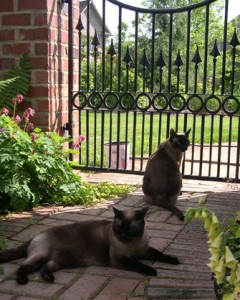 If you are both a gardener and a cat lover you might want to share your garden with your furry friends. Ideally, this garden would be an enclosed or contained space so they would not be able to roam and find their way into danger. Alternatively, if you have docile cats, you might be able to enjoy the garden together as a supervised garden visit. Certainly making the garden especially appealing to cats will entice them to stay in the garden rather than seek pleasure elsewhere.
If you are both a gardener and a cat lover you might want to share your garden with your furry friends. Ideally, this garden would be an enclosed or contained space so they would not be able to roam and find their way into danger. Alternatively, if you have docile cats, you might be able to enjoy the garden together as a supervised garden visit. Certainly making the garden especially appealing to cats will entice them to stay in the garden rather than seek pleasure elsewhere.
There are a variety of things that you can do to make the garden attractive yet safe for cats.
1. PROVIDE PLANTS ATTRACTIVE TO CATS
Cats find the scents of certain plants irresistible and want to roll in them as well as eat them. Like people, not all cats are going to be attracted the same plan but by trying them out you can find the favorites and focus on them.
Catnip (Nepetta cataria)
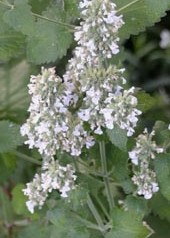 Perhaps the best known of the plants that cats adore, this large plant is also grown for its ornamental value as a garden plant. The small flowers are white with purple-pink spots and carried in dense terminal clusters. The ovate leaves are coarsely toothed, gray-green, and downy. Cats like the smell of the leaves that is released when the animals roll around in them.
Perhaps the best known of the plants that cats adore, this large plant is also grown for its ornamental value as a garden plant. The small flowers are white with purple-pink spots and carried in dense terminal clusters. The ovate leaves are coarsely toothed, gray-green, and downy. Cats like the smell of the leaves that is released when the animals roll around in them.
Type: Short lived herbaceous perennial
Height:20-39″
Light:Full sun to partial shade
Soil:Average, medium moist, well-drained; drought tolerant
Hardiness: Zones 4-8
Catmint (Nepeta faassenii)
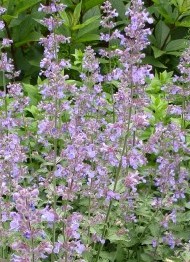 This popular garden plant produces an airy mass of lavender-blue spikes in the summer. The foliage is gray-green and aromatic. Cats are attracted to the aroma that is released from the leaves when they bruise them.
This popular garden plant produces an airy mass of lavender-blue spikes in the summer. The foliage is gray-green and aromatic. Cats are attracted to the aroma that is released from the leaves when they bruise them.
Type:Herbaceous perennial
Height: 1-2
Light: Full sun
Soil: Average, medium moist, well-drained; tolerates some drought once established
Hardiness: Zones 4-7
Valerian (Valeriana officinalis)
Valerian appeals to both cats and rats so you might not want to plant it close to the house. In addition, 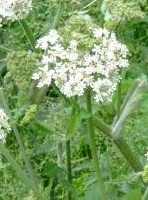 the scent of the leaves that is so attractive to cats smells like cat urine. It has been grown since ancient times for its medicinal value and is still cultivated in Germany for that urpose. The small sweet smelling flowers that appear in summer, are pink-tinged and carried in four inch wide panicles. The leaves are dark green and pinnately compound.
the scent of the leaves that is so attractive to cats smells like cat urine. It has been grown since ancient times for its medicinal value and is still cultivated in Germany for that urpose. The small sweet smelling flowers that appear in summer, are pink-tinged and carried in four inch wide panicles. The leaves are dark green and pinnately compound.
Type:Herbaceous perennial
Height:3.5-5′
Light: Full sun to part shade
Soil: Fertile, moist
Hardiness:Zones 4-8
Grass
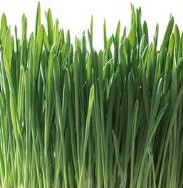 Although most grasses will satisfy cats, wheat grass (Avena sativa) and cock’s foot (Dactylis glomerata) are the most popular. The wheat grass is most likely to be seen for sale in pet stores, the cock’s foot has a high sugar content so may be more appealing. There is no agreement among vets or cat lovers as to why cats eat grass but there also seems to be no harm in letting cats eat it. A benefit may be diverting the cats from eating other plants. Since cats usually vomit afterward eating grass you have to consider clean-up. Whatever grass you choose to grow for your cat make it available when the grass is young and before it flowers as old leaves and flowering parts can be hard on the cats’ GI track.
Although most grasses will satisfy cats, wheat grass (Avena sativa) and cock’s foot (Dactylis glomerata) are the most popular. The wheat grass is most likely to be seen for sale in pet stores, the cock’s foot has a high sugar content so may be more appealing. There is no agreement among vets or cat lovers as to why cats eat grass but there also seems to be no harm in letting cats eat it. A benefit may be diverting the cats from eating other plants. Since cats usually vomit afterward eating grass you have to consider clean-up. Whatever grass you choose to grow for your cat make it available when the grass is young and before it flowers as old leaves and flowering parts can be hard on the cats’ GI track.
Avena sativa
Type: Annual
Height: 36″
Light:Full sun
Soil:Average, dry to medium moist, well-drained; drought tolerant
Hardiness: Not applicable
oisonous
Type: Cool season perennial grass
Height: 8-55″ H
Light:Full sun to partial shade
Soil:Fertile, medium moist, well-drained
Hardiness:Zones 3-9
2. PROVIDE WATER
In addition to plants, be sure to include a fresh water supply especially of the cats are going to spend a long time in the garden. A good supply of water is essential for the long term health of cats.
3. AVOID
a. Poisonous plants that could hurt your cats such as lilies, ivy, chrysanthemums, philodendrons, azaleas, delphiniums, daffodils, oleander, wisteria, foxgloves,
b. Pesticides where cats will eat or lie in the vegetation. Cats are constantly licking their coats to clean them so any pesticide that gets on their fir will most likely be ingested.
4. PROTECT BIRDS
Place bird feeders and nesting boxes far from the cat garden so kitty will not be tempted and the birds will be safe.
5. PROTECT GARDEN PLANTS
By placing twigs and small branches among plants and in seed beds discourage discourage kitty from wandering through them.